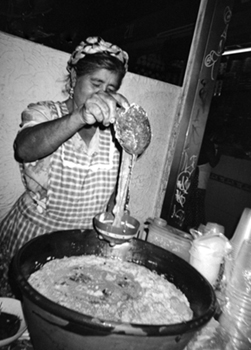|
Story and photos by Liz & Brian Parr (copyright 2003)
In markets and ferias, phalanxes of women stand at attention behind the green glazed tubs of tejate like a broad-bosomed kettle drum section in
checkered aprons. Tejate is a drink championed as refreshing, invigorating, aphrodisiacal, and medicinal, once drunk by Zapotec kings; today, campesinos
gird themselves for the weary day ahead with this cool and chocolatey concoction. But, to the unschooled eye, oblivious to the tastes of Zapotec
royalty, tejate may look like either sink water after a man shaves, or what one might imagine when thinking of the word "curd". Working from the philosophy
that, if people eat it, it must be good (a philosophy of goofy optimism which did not pan out in several cases, for example, that of "stinky tofu" in China),
I investigated the history and merits of this popular Oaxacan beverage.
 |
Tejate is made of precisely toasted corn, cacao, cinnamon, and the seeds and flowers of a fruit called mamey which has skin like a kiwi and the
grainy orange flesh of a yam, but more chalky, and with a central seed the size of a large almond. The tejatera, the woman who makes tejate, several of whom
told me all these things, toasts these ingredients perfectly each night before she uses them. Knowing how to do this is a skill passed from mother to daughter
tejateras. The cleanliness of the seeds and bowls is vital. Grease or fruit stuck on the mamey seeds will render the whole stew the wrong color and all the
other tejeras will scowl.
|
In the morning, having guarded cleanliness and toasted all to a turn with Zen-like attention, she grinds everything up on her metate with which
every woman comes equipped as a wife, dollops what must be a greyish gravy all into a pot, sloshes in cold water and ice, mixes it until what I would describe
as a bubbly spume is developed like foam on a stormy beach, scum to be discarded from boiling chicken, or unhealthy beer. But, two million Oaxacan's (and this
is a Oaxaqueno libation, several Mexicans with whom I spoke had never tried tejate, and thought it looked suspiciously rustic) can't be wrong.
Tejate is a staple at ferias and mercados capturing the romanticism and purity of an agricultural past, thatched roofs, hay in the sun, fields under a harvest
moon. Traditionally, it is scooped up and proffered in hollowed, finely painted, gourd bowls, once painted only by the townfolk of the Guerrero hills, now it is
swirled into opaque plastic Solo cups. Further, the drink itself has not always been the curdy refreshment we know today. Once more like atole and made with chile
de arbol, men could carry chunks of it in their breakfast sacks to the field. Now its wetter, and sweet rather than spicy.
Keeping in mind the sophisticated pallets of Zapotec kings and promises of aphrodisiacal effects, I stepped up to the tejate pot at Oaxaca's hip Conzatti market to
ask for one para levar. Everybody was gobbling this stuff. I took my place in a substantial line behind a boy of about 12 in a tidy button-down, clearly an afficionado,
who took his tejate neat from the flamboyantly enamelled gourd and stood with his mother lapping the creamy froth from the bowl. A tall sleek girl with golden sunglasses
on her head and eyes like a deer took hers to go, biting at the foam, and two guffawing school girls with braces on their teeth walloping each other, sloshed their
plastic cups and, shreiking, the chunks from their wrists.
My turn. From a little galvanized bucket, the tejatera scooped in an inch of sugar water of which you can have more or less, the sweetness must be necessary since
unamended cacao is cruelly bitter. Then, swirling expertly for the proper liquid to foam ratio, my tejatera scraped the side of the tub, dolloped it all into my cup and
plopped in a chunk of ice. As it turned out, it was delightful, or, at least, cool and chocolatey. A pre-Hispanic Yoo Hoo. Rather than a grainy spume, the froth was
melting and creamy, the sweetness invigorating not cloying.
There is in Spanish a specific word, madrugada, for the crack of dawn between 3 and 4 in the morning when women get up tostart the fire, pat the tortillas, and get the
men ready for their long days. One can imagine a cool gourdful of tejate in the early hours to gird you for the long day.
Editor's Note: Liz & Brian Parr live in Oaxaca. Liz is a graduate student working, with her husband, Brian, on a kitchen garden project in the green and
mountainy Mixteca region of Oaxaca. You can e-mail them at brianlizparr@hotmail.com
Do you have a unique story about Mexico, it's history, culture or your own travels that our readers might enjoy here on Mexonline.com? If so we'd be happy to read it and consider it for inclusion into our Feature Stories section. Just take a look at our writer's guidelines for more information and how to send us your story. Let's hear from you!
|